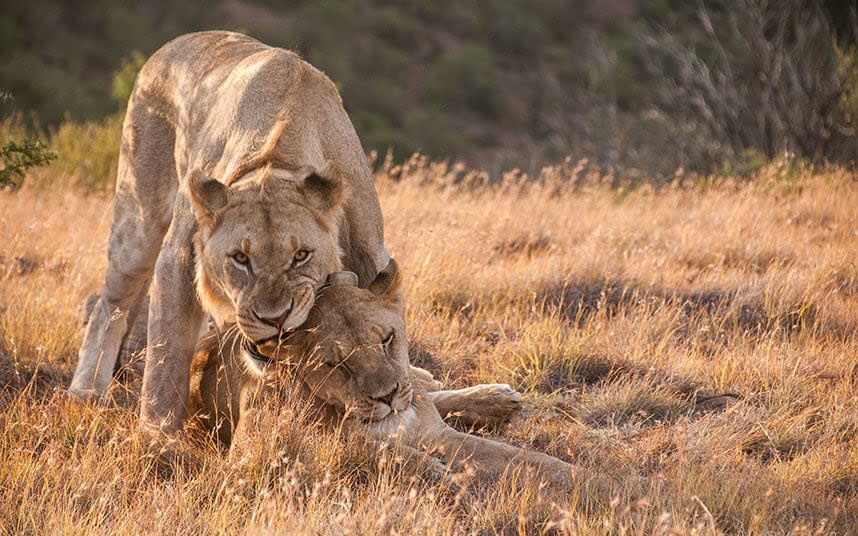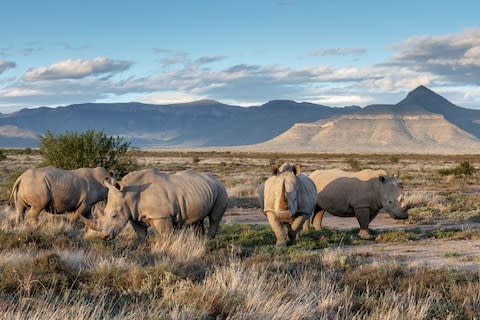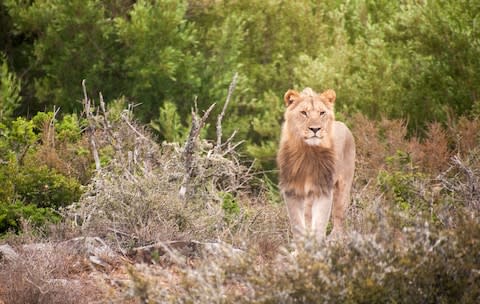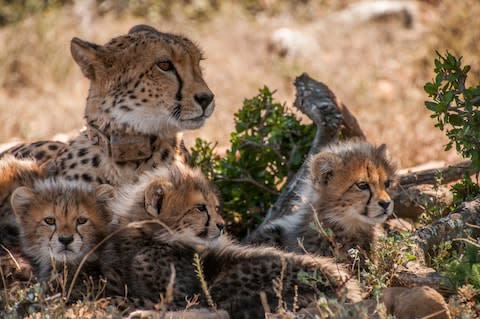South African reserve reintroduces lions for first time in 180 years - now is the time to go

There she reclined, lithe limbs outstretched, soaking up the South African sun – and from the moment she sat up and looked at me, I knew it was love at first sight. I had flown 2,000 miles for this moment and wasn’t disappointed. After all, it is not every day that you are invited to meet a very special lion.
To those who know South Africa only through visits to the Kruger or the boutique game parks of the Sabi Sands, Samara Private Game Reserve is a revelation. Wrapped around by gaunt hog-backed mountains, its 70,000 acres of arid bushveld lie in the heart of the Great Karoo, a malaria-free area the size of Germany that has long held a special place in the heart of many South Africans for its desolate beauty and pioneering history.
To the south, only a couple of hours’ drive away lies the Garden Route, the tourist highway that hugs the coast from Cape Town to Port Elizabeth. But for most visitors the Great Karoo – that ancient land of dinosaur bones and Khoisan cave paintings – remains a mystery.
It was the Khoisan who called it the Karoo – the “Dry Place where there is nothing”. Seen through the trembling desert air, its shadowy kloofs and rippling summits dissolve into shimmering swirls of burnt sienna and iceberg blue, and so profound is its all-embracing silence that it is even possible for scientists to record the eerie sounds of our planet rolling in space on its journey around the sun.
Two hundred years ago, the Great Karoo was a haven for wildlife. Vast herds of eland and Cape buffalo roamed the grasslands. Black rhinos thrived in its thorny thickets. Herds of elephants meandered up from the coast to feed on the green mountain slopes and every year was marked by the spectacle of the springbok migration, when up to a million of these fleet-footed antelopes merged into a single herd three miles wide, leaving clouds of dust in their wake that took two weeks to settle.

Above all, one animal held sway over the Karoo. This was the majestic Cape lion, a fearsome carnivore whose widespread presence and formidable reputation made travel by ox-wagon impossible at night.
Today, the wandering herds are no more. Fences and guns stopped the springbok in its tracks and the Cape lion has not been seen for nearly two centuries. Yet the wild spirit of the land itself remains unbroken, reaching out to those who are drawn to its sunstruck plains and boundless space.
Among them is Sarah Tompkins who, with Mark, her English husband, has demonstrated how hands-on conservation can transform 70,000 acres of clapped-out farmland into a hugely successful born-again wilderness. “I didn’t really choose the Karoo,” she said. “It chose me.”
Having bought the land in 1997, they immediately set about removing the fences and restocking it with indigenous wildlife. “Our vision was to restore the Great Karoo to its former glory,” she said, “to create a fully functioning ecosystem with all its original species.”

At the same time two luxurious safari lodges were created for the kind of visitors who want to escape from the modern world and return to the one that used to be. One, Karoo Lodge, is a tastefully restored 1800s homestead. The other is the Manor, a sumptuous villa overlooking a long turquoise swimming pool, and between them they sleep a maximum of just 26 guests.
When I first visited Samara in 2007 the reserve could already boast an impressive list of animals that had roamed here before the settlers arrived, including oryx, kudu, eland and hartebeest. Among them were rare white and black rhino, the highly endangered Cape mountain zebra and the first cheetahs to be seen for 130 years.
Last November Sarah Tompkins’s dream came another step closer to realisation when two bull elephants arrived from Phinda in KwaZulu-Natal to join a herd of six females that had been acquired a month earlier. Together they are already beginning to reshape the landscape, roaming Samara’s mountain slopes in search of succulent cabbage trees and bulldozing new pathways through the bush.

Only one long-held ambition remained. For the Karoo’s natural ecosystem to function properly it needed the lions that were once its apex predators. It was time to return South Africa’s vanished kings to the realm from which they were banished 180 years ago.
So it was in the run-up to Christmas that I was invited to Samara to meet the four-year-old lioness and her intended mate whose progeny, it was hoped, would return the Karoo to its former glory. They had arrived a week earlier from Kwandwe game reserve, 150 miles away on the Great Fish River.
Having been sedated for the long road journey they had woken up to find themselves at Samara in an enclosure the size of a football pitch surrounded by a 10ft-high electric fence. This was the first time they had seen each other, as both cats had been selected from unrelated prides to ensure genetic diversity; but a tasty kudu carcase soon broke the ice and in no time they were feeding amicably together.
Here they would remain for up to six weeks before being released – an operation successfully completed last month – following a plan drawn up with the expert help of Graham Kerley, professor of zoology at Nelson Mandela University in Port Elizabeth. “It’s essential that they never associate feeding with humans,” he said. “That’s why their meals are delivered down a chute from behind a canvas wall that keeps everyone out of sight.”

The Tompkins’s plans for rewilding the Great Karoo couldn’t have come at a better time for lions. Of the 200,000 that roamed across Africa in the Eighties, no more than 23,000 survive today, with just 3,000 left in South Africa itself, leading to fears that the species could disappear from the wild in three decades.
From our Land Cruiser, parked a discreet distance away, I could clearly see both lions. The male was greyer than his bride-to-be and a year younger, with huge paws that still seemed too big for his body, but already he had the makings of a fine mane. We watched him slowly rise to his feet and approach the lioness, greeting her with an affectionate bout of head rubbing until she gave him a grimace, exposing her canines as if to say “That’s enough for now”.
Leaving the cats to their siesta, I set out with Sarah to see what else Samara had to offer. Drought gripped the land. The sun glittered on a million thorns and the wind hissed in the withered yellow grass, but the animals knew where to find water in the hidden pools of the Milk River Valley.

Like the Karoo itself, they were incredibly resilient and perfectly at home in the harsh but overwhelmingly beautiful lost world of the Khoisan that Sarah Tompkins is bringing back to life. Bull elands with swinging dewlaps cantered away through dense stands of flowering acacias. Oryx and hartebeest watched us from a distance and blue cranes – elegant birds the colour of wood smoke – filled the air with their sweet-throated cries.
Shepherd’s trees with ghostly white trunks stood out like markers, measuring the illimitable seas of bush, and when we stopped for a midmorning coffee I scanned the mountainsides with my binoculars and found a black rhino. On a distant slope littered with smooth grey boulders it was the only one that moved.
Not long afterwards we found a mother cheetah with five small cubs resting in the shade. Her name was Chilli and I was thrilled to be told she was the daughter of Sibella, who I had met on my first visit to Samara 11 years ago. Sibella had died in 2016, but not before producing 20 cubs and raising all but one to adulthood.

On we drove through wild orchards of jacket plums until we came to Wolwe Kloof (Hyena Valley), toiling in bottom gear up a tortuous pathway to the breezy summit of Kondoa, a miniature Serengeti marooned in the sky along with its cavorting wildebeest herds.
There, a picnic of chicken and chilled sauvignon had been prepared under a canvas awning with stupendous views past dolerite cliffs where kestrels hung in the wind and sentinel baboons kept watch over the Plains of Camdeboo 2,500ft (760m) below. Towards the end of the day we drove back to the boma for one final look at the lions. By the time we arrived the sun was sinking through long reefs of cloud and a warm desert wind had begun to blow.
They were still resting together as we had left them, their flanks backlit in the golden glow as if carved from amber, and whenever the lioness raised her head I would feel her unblinking gaze rifling deep into my soul. “We’ve called the male Titus but we haven’t yet decided on a name for her,” whispered Sarah. “Perhaps you would like to think of one?”
I looked at her sphinx-like silhouette, lying in the last of the light like a benediction, the founder of a new dynasty whose broad footprints would soon blossom along Samara’s dusty game trails and whose thunderous voices would once again echo among the kloofs and hollows of the mountains, telling the world the vanished kings were back where they belonged.
“Let’s call her Sikelele,” I said, “the Xhosa word for blessed.”
The essentials
Cazenove & Loyd (020 7384 2332; cazloyd.com) is offering a one-week safari holiday in South Africa from £2,500 per person. The price includes five nights at Samara in a luxurious Karoo Suite and two nights at the Drostdy Hotel in Graaff-Reinet, plus internal flights with South African Airways from Johannesburg to Port Elizabeth and transfers. Return economy-class flights from London Heathrow to Johannesburg with South African Airways (flysaa.com) from £700.

